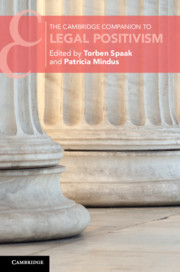Book contents
- The Cambridge Companion to Legal Positivism
- Cambridge Companions to Law
- The Cambridge Companion to Legal Positivism
- Copyright page
- Contents
- Figures
- Contributors
- Acknowledgements
- 1 Introduction
- Part I Fundamentals
- Part II History
- Part III Central Figures
- 9 Jeremy Bentham and the Origins of Legal Positivism
- 10 John Austin
- 11 The Normative Power of the Factual: Georg Jellinek’s Phenomenological Theory of Reflective Legal Positivism
- 12 Hans Kelsen’s Non-Reductive Positivism
- 13 The Legal Positivism of H. L. A. Hart
- 14 From Savigny to Linguistic Analysis: Legal Positivism through Bobbio’s Eyes
- 15 Joseph Raz’s Approach to Legal Positivism
- 16 Bulygin’s Analytical Legal Positivism
- Part IV Main Tenets
- Part V Normativity and Values
- Part VI Critique
- Index
- References
14 - From Savigny to Linguistic Analysis: Legal Positivism through Bobbio’s Eyes
from Part III - Central Figures
Published online by Cambridge University Press: 21 January 2021
- The Cambridge Companion to Legal Positivism
- Cambridge Companions to Law
- The Cambridge Companion to Legal Positivism
- Copyright page
- Contents
- Figures
- Contributors
- Acknowledgements
- 1 Introduction
- Part I Fundamentals
- Part II History
- Part III Central Figures
- 9 Jeremy Bentham and the Origins of Legal Positivism
- 10 John Austin
- 11 The Normative Power of the Factual: Georg Jellinek’s Phenomenological Theory of Reflective Legal Positivism
- 12 Hans Kelsen’s Non-Reductive Positivism
- 13 The Legal Positivism of H. L. A. Hart
- 14 From Savigny to Linguistic Analysis: Legal Positivism through Bobbio’s Eyes
- 15 Joseph Raz’s Approach to Legal Positivism
- 16 Bulygin’s Analytical Legal Positivism
- Part IV Main Tenets
- Part V Normativity and Values
- Part VI Critique
- Index
- References
Summary
Chiassoni explains that in the early 1960s Norberto Bobbio put forward a descriptive theory of legal positivism consisting of two main parts, namely, a definition of legal positivism, according to which there is no law but positive law (the exclusivity thesis) and an analysis of legal positivism that identifies three versions of legal positivism: legal positivism as an approach to the study of law (scientific positivism), legal positivism as a theory of positive law (theoretical positivism) and legal positivism as a doctrine of obedience to positive law qua law (ideological positivism). He explains that legal positivism as an approach to the study of law involves a commitment to a value-neutral study of positive law; that legal positivism as a theory of positive law encompasses (what he refers to as) narrow theoretical positivism as well as broad theoretical positivism; and that we may distinguish between three versions of legal positivism as a doctrine of obedience to positive law qua law, namely, an unconditional version, a moderate, conditional, relative version, and a very moderate, conditional, relative version, and that these versions differ in important ways.
Keywords
- Type
- Chapter
- Information
- The Cambridge Companion to Legal Positivism , pp. 325 - 348Publisher: Cambridge University PressPrint publication year: 2021

